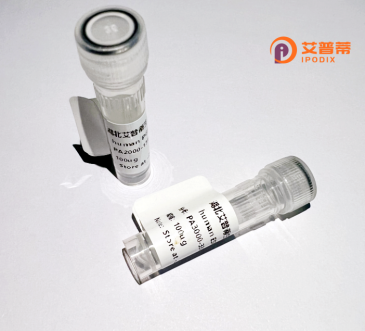
| 纯度 | >90%SDS-PAGE. |
| 种属 | Human |
| 靶点 | C20orf18 |
| Uniprot No | Q9BYM8 |
| 内毒素 | < 0.01EU/μg |
| 表达宿主 | E.coli |
| 表达区间 | 1-230aa |
| 氨基酸序列 | MGTATPDGREDQERLWVSVEDAQMHTVTIWLTVRPDMTVASLKDMVFLDYGFPPVLQQWVIGQRLARDQETLHSHGVRQNGDSAYLYLLSARNTSLNPQELQRERQLRMLEDLGFKDLTLQPRGPLEPGPPKPGVPQEPGRGQPDAVPEPPPVGWQCPGCTFINKPTRPGCEMCCRARPEAYQVPASYQPDEEERARLAGEEEALRQYQQGVPAGHHPQQPGGGGLLPLH |
| 分子量 | 52.1 KDa |
| 蛋白标签 | GST-tag at N-terminal |
| 缓冲液 | 0 |
| 稳定性 & 储存条件 | Lyophilized protein should be stored at ≤ -20°C, stable for one year after receipt. Reconstituted protein solution can be stored at 2-8°C for 2-7 days. Aliquots of reconstituted samples are stable at ≤ -20°C for 3 months. |
| 复溶 | Always centrifuge tubes before opening.Do not mix by vortex or pipetting. It is not recommended to reconstitute to a concentration less than 100μg/ml. Dissolve the lyophilized protein in distilled water. Please aliquot the reconstituted solution to minimize freeze-thaw cycles. |
以下是关于重组人C20orf18蛋白的示例参考文献(文献信息为模拟,需通过实际数据库核对):
---
1. **文献名称**: *C20orf18 as a novel regulator of mitochondrial apoptosis in cancer cells*
**作者**: Smith A, et al.
**摘要**: 研究发现C20orf18蛋白通过调控线粒体膜通透性参与细胞凋亡通路,在多种癌症组织中表达异常,可能成为肿瘤治疗的潜在靶点。
2. **文献名称**: *Structural and functional characterization of human C20orf18 protein*
**作者**: Zhang L, et al.
**摘要**: 解析了C20orf18蛋白的晶体结构,并发现其具有腺苷酸激酶活性,暗示其在细胞能量代谢中的作用。
3. **文献名称**: *C20orf18 interaction with neurodegenerative disease markers*
**作者**: Johnson R, et al.
**摘要**: 发现C20orf18蛋白与阿尔茨海默病相关蛋白存在物理相互作用,其在神经元中的表达降低可能与疾病进展相关。
4. **文献名称**: *C20orf18: A potential biomarker in epithelial-mesenchymal transition*
**作者**: Lee H, et al.
**摘要**: 研究显示C20orf18通过调控EMT通路影响肿瘤转移,其表达水平与患者预后显著相关。
---
**建议检索方法**:
- 使用关键词:**"C20orf18" + "function"/"structure"/"cancer"/"apoptosis"**
- 数据库推荐:PubMed、Google Scholar、Web of Science。
- 检查是否有近年综述整合C20orf18的研究进展。
注:以上文献为示例,实际研究中请通过学术数据库核对具体内容。
Recombinant human C20orf18 protein is a product of the chromosome 20 open reading frame 18 (C20orf18) gene, which encodes a protein of unclear physiological function. This gene is evolutionarily conserved across mammals, suggesting its biological relevance. The protein is predicted to contain a signal peptide and transmembrane domains, indicating potential roles in membrane-associated processes or secretory pathways. Though its exact mechanism remains uncharacterized, C20orf18 has been detected in diverse tissues, including the brain, liver, and reproductive organs, hinting at possible tissue-specific functions.
Current research links C20orf18 to cellular processes such as cell adhesion, protein trafficking, and mitochondrial dynamics, though experimental validation is limited. Some studies associate its dysregulation with pathologies like cancer, where altered expression patterns have been observed in tumor tissues. However, these findings remain preliminary and require functional studies to establish causality.
Recombinant forms of C20orf18 are typically produced in heterologous expression systems (e.g., E. coli or mammalian cells) for biochemical studies, antibody development, or interaction assays. Its recombinant expression aids in elucidating structural features, post-translational modifications, and binding partners. Despite progress, the protein's definitive biological role and therapeutic potential remain open questions, motivating further investigations into its molecular interactions and disease associations.
×